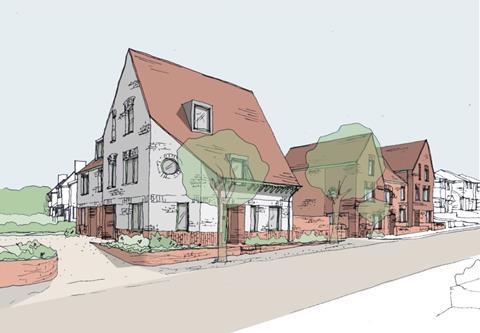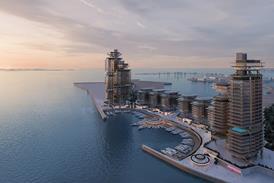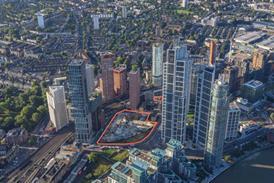Labour’s new towns plan won’t deliver the homes we need anytime soon. To boost sustainable housing sooner, we should look to our suburbs, writes Russell Curtis

In recent weeks the Labour party has reaffirmed its commitment to building 1.5m homes in its first term of government. What is not yet clear is how it intends to achieve this figure. Part of the strategy is a new towns programme, as announced by Angela Rayner at the UKREiiF property conference in Leeds last month and confirmed in last week’s manifesto.
But, while building new settlements in the countryside is a headline-grabbing proposal, this is a multi-year enterprise, relying at the very least on compulsory purchase reform, huge investment in infrastructure, changes to strategic planning, and the formation of development corporations. Even with a good headwind and an improving economy, there’s little chance of the target 300,000 homes each year being built via this route any time soon.
The UK has not achieved anywhere near this level of housing delivery since the 1970s, despite this being a central tenet of the Tory manifesto. Housebuilding has sent the Conservatives into paroxysms, with its own backbench MPs campaigning against the very policies ministers have claimed are necessary to meet these targets. So how might a new administration jump-start housing delivery without getting bogged down in the quagmire of long overdue planning reform? The leafy suburbs of south London might provide a clue.
In 2017 Croydon Council published guidelines setting out how its outlying areas should be gradually intensified through small site development. The council was already delivering a heroic number of new homes through the development around East Croydon station, although for a time this included a large number of very poor office-to-residential conversions. Rightly identifying that every part of the borough has a part to play in meeting the city’s acute housing need, its Suburban Design Guide received plaudits as an innovative way to meet its housing targets as set out in the London Plan.
The guidance was intended to provide applicants with certainty around what type of development would receive support. It included a range of long-term development scenarios which showed how different suburban conditions might evolve over the next 20 years, providing explicit examples setting out how, for example, a single detached family house on a large plot might be demolished and replaced by a block of flats facing the street, augmented by a small terrace of townhouses to the rear. Other examples set out conditions through which semi-detached and terraced houses might be redeveloped to significantly intensify individual plots and, through assembly of adjoining dwellings, push the uplift even higher.
>> Also read: Strong rhetoric on planning but no surprises as Keir Starmer launches Labour manifesto
Armed with this guidance, small developers could acquire land with a good idea of what it was worth, due to the ability to predict what might be built on it with a high degree of certainty. And by following the guidance in the SPD, schemes could be drawn up by architects safe in the knowledge that they would be supported by planning officers. The accurate balancing of acquisition cost and development value also meant that there was little benefit to flipping sites, in the hope that each time this happened a little more could be squeezed from the scheme — a phenomenon which pioneering small site developer Roger Zogolovitch referred to as “pass the parcel”.
The Croydon guidance focused on a handful of areas identified for intensification where the council believed there was greatest capacity for new homes — primarily those with low densities but close to high streets or train stations. The results of this policy were remarkable: in a four-year period, Croydon delivered nearly 2,000 homes on small sites, three quarters of which were within developments comprising fewer than 10 homes — by far the largest number of any borough in London. That’s not just approved, but built. The second highest (some way behind) was Barnet, which in the same period managed 700, despite being almost exactly the same size and having the same area of green belt.
Current green belt designations make little sense where there’s nothing to distinguish it from the boundaries of those cities it’s intended to constrain
Extrapolating this approach across the remainder of London’s low-density suburbs surely has the potential to yield a very large number of new homes. But how many?
Most of central London sits somewhere between 20 and 60 homes per hectare (dph), with a few pockets around Kensington, Bayswater, Tower Hamlets and Maida Vale which top out at about 150dph. In outer areas this drops as low as two dwellings per hectare, even within ten minutes’ walk of suburban stations (Crews Hill, in Enfield’s green belt is an egregious example; albeit soon to be corrected).
This is clearly an aberration in a world city, particularly when one considers the massive green belt, the very purpose of which is to promote urban intensification. Current green belt designations make little sense where there’s nothing to distinguish it from the boundaries of those cities it’s intended to constrain. 10% of London’s total area is located within ten minutes’ walk of a station whilst simultaneously having a residential density of less than 20 dwellings per hectare.

An obvious route to meeting the one-and-a-half million homes that Labour has committed to would look more closely at these areas and focus development on suburban intensification. Croydon has shown this can work. But development of this scale does not come without compromises, and incoming Conservative mayor Jason Perry unceremoniously scrapped the SPD after running on an unashamedly NIMBY ticket.
Across London there’s around 47,000 hectares of suburban housing within 800m of a station, once protected open space and industrial land are removed. This has an average density of just over 31 dwellings per hectare. An uplift of just 25% in density, capped at 100dph and no lower than 40dph, could yield some 900,000 homes — just in those areas less than ten minutes’ walk from a station. Coupled with more modest increases outside these areas, the figure is well north of a million — and that’s just in London alone.
Expanding this approach across the rest of the country could easily get to the targets that Labour has set for itself; putting a rocket booster under regional economies to boot, as local developers, trades and supply chains respond to a sudden increase in demand for their services. Berkeley Homes alone currently builds around 10% of all homes in London. This isn’t a healthy state of affairs, but when we place so many hurdles in the way of small-scale development, it’s no wonder we suffer from housebuilding hegemony.
There are myriad examples across London of sprawling, inefficient, land-hungry houses being replaced by compact and sustainable family homes
40 dwellings per hectare isn’t high, being equivalent to a neighbourhood of two-storey Victorian terraces. Applying a 25% increase in density to all of the areas identified, with a minimum threshold of 40 and a maximum of 100 and making a modest adjustment for those parts of London which have a high proportion of detached and semi-detached houses or large gardens, the areas within 10 minutes’ walk of London’s stations can accommodate around 850,000 homes. Include the areas just outside this, and there’s potential for over a million. Far from being a “war on the suburbs” as some have claimed — such an approach would help breathe new life into them.
Despite the protestations of comfortable suburban homeowners, suburban intensification would not radically transform the character of their neighbourhoods. There are myriad examples across London of sprawling, inefficient, land-hungry houses being replaced by compact and sustainable family homes. A charming example of this is to be found in Purley, where small site specialists Harp & Harp have designed seven new family homes on a corner plot. Repeating this on each corner of the block would easily achieve a 40% uplift in density, whilst being entirely compatible with local character. Yet local Nimbys have repeatedly attempted to challenge the planning approval, including at the High Court, no less.

What policy levers might an incoming government pull to jump-start intensification? Paragraph 129 of the National Planning Policy Framework already states that local plans “should include the use of minimum density standards for city and town centres and other locations that are well served by public transport.” However, a get-out clause remains: authorities can knock back development “if the resulting built form would be wholly out of character with the existing area”.
It’s time to pop that statement in the recycling bin. Instead, the government should follow examples in Canada and New Zealand and adopt a very strong presumption in favour of intensification close to stations, coupled with a prohibition on minor applications being decided under anything other than delegated powers. National housing targets should include a proportion to be delivered on small sites, rather than considering these as “windfall”. Finally, all planning authorities should be mandated to produce small site design codes, with a national version to fall back on should they refuse to do so.
Labour has already identified the lagging economy, pitiful productivity and the dire social and environmental consequences of poor-quality housing as major barriers to growth, but the idea that it can deliver 1.5 million homes via a new town programme in the first term of government if for the birds. Rapid intensification of our cities’ suburbs might offer a solution.
>> Also read: Starmer to present ‘new towns’ plan as part of ‘national renewal’ strategy
>> Also read: Why do we struggle to densify suburbia?
















4 Readers' comments